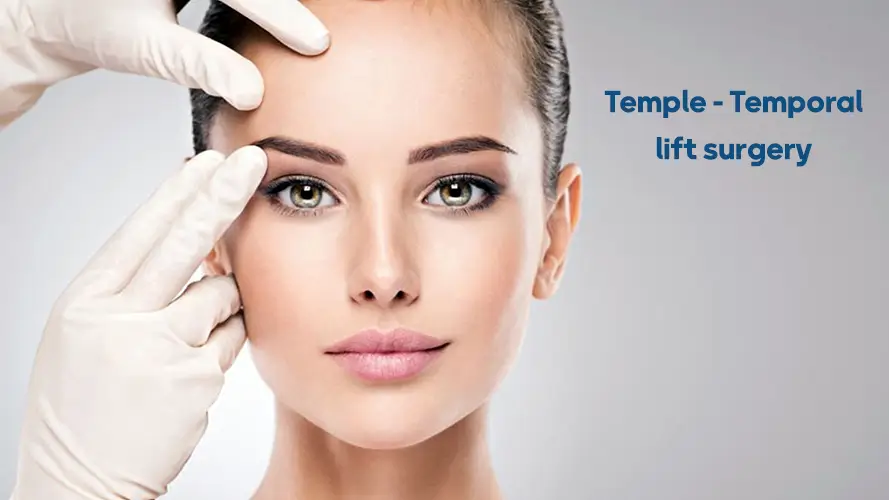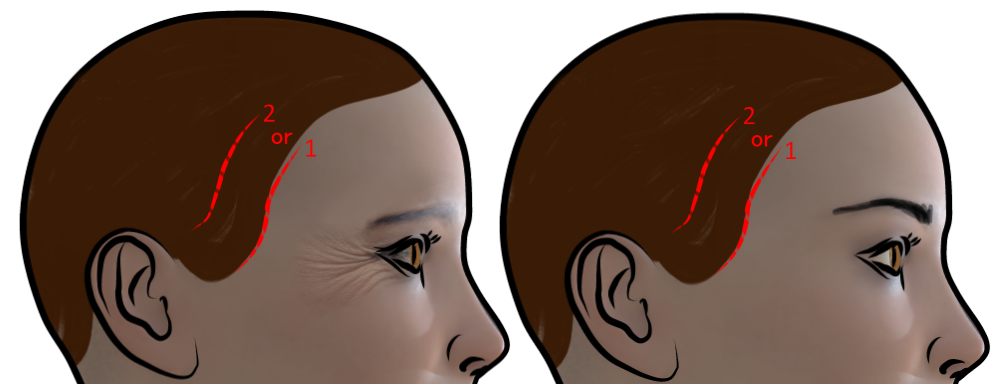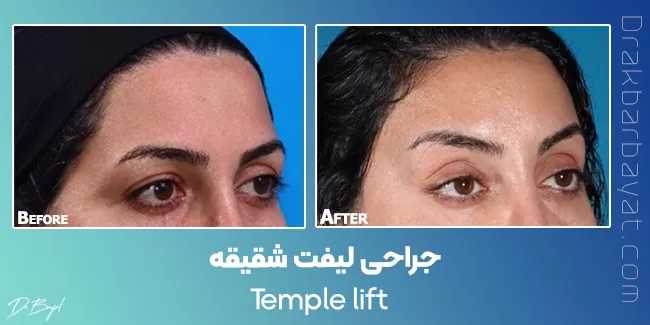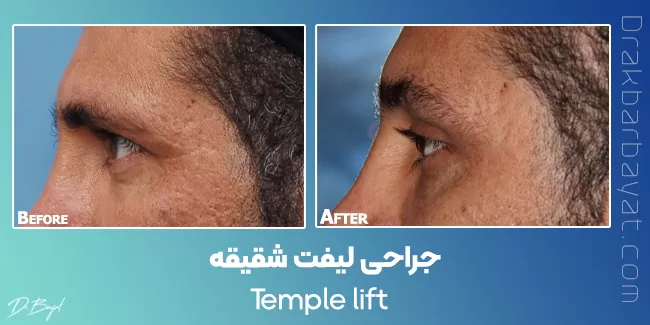
Temporal lift surgery
Anatomically, temple is the side of the forehead, and temple lift means elevating the lateral part of the forehead. As most of the facial beautifying candidates pay special attention to this region, we evaluate it separately from forehead lift.

In temple lift, the applicants often expect that the eyebrows tails are elevated (3/1 outer brows) and the eyes are stretched. Temple lift reduces the wrinkles around the eye and upper eyelid puffiness and it thus causes the tired and sleepy eyes to become open and look younger. Temple lift has an indirect effect on the eyes, but this effect gets a lot of attention from the people around. The cheeks become more augmented in people who perform the mid face lift at the same time.
Is the temple lift separated from the forehead and brow lift?
The fat in the temple area contains different layers. This fat is larger in volume in women than in men. As all fat-containing layers in the temporal area are more superficial than the temporalis muscle, the presence of adequate fat in these layers can easily fill the unevenness of temporal area and create an even smooth region around the eyes. This way, one’s eyes become more the focus of attention. This fat is larger in volume in women than in men. As we get older, some diseases, severe weight changes, and the fat in the temple area undergo lipoatrophy and lipodystrophy. This leads to temporal hollowing. Temporal hollowing causes a person to appear older and exhausted and extremely reduces the face, and especially eyes’ attractiveness.

Forehead and brow lift is performed to elevate the whole eyebrow and eliminate the entire forehead wrinkles (and even the frown line). Therefore, the surgery region is wider in the forehead lift, while the temple lift is in fact the lift of the lateral parts of the forehead and includes a narrower region of the surgery. Most of the temple lift candidates are young people who do not have aging signs and wrinkles in the mid part of the forehead (e.g., have no frown line to be corrected) and only want to make changes around their eyes and brows.
Who are the right candidates for temple lift?
- People who experience early eyebrow drooping at an early youth age due to genetic reasons.
- People with the laxity and descent of temporal area tissues, especially eyebrow tail caused by aging
- People who want the tails of their eyebrows to be in a higher position than their status quo.
- People who want their eyes to look more stretched.
How is a temple lift performed?
Classic endoscopic method is the most common temple lift procedure and most surgeons only use this method. In this method, an incision is made within the hair. The endoscopic and surgical tools are then introduced and by releasing and lifting the soft tissue from the sheath of the temporalis muscle and the skull bone, they are fixed to the upper parts using sutures or endotine. No skin is removed in this method. Most candidates of this method are the youth who do not need the whole brow lift.
In addition to obtaining the above result, your other demands may also be met in the modified temple lift methods. These demands include the following:
- The temple hairline can be moved forward or backward
- Excessive protrusion of the bony ridge around the eye sockets (orbits) can be shaved.
- Excessive skin removal is possible
- Prosthesis installation in the temporal region or tissue grafting for temple is possible.
- Scars caused by previous surgeries can be eliminated
- Simultaneous mid face lift and lower face lift are possible.
Therefore you are suggested to completely specify your demands prior to the operation so that the surgeon can implement the best method to meet your demands.
What are the complications of temple lift?
Obviously, no surgery is risk-free and without complications, but the amount of risk is different in various surgeries. The most important complication of temple lift surgery can be the damage to the frontal branch (forehead branch) of the frontal motor nerve. Fortunately, there is a very low risk of permanent damage as this branch is covered by strong layers of superficial fascia. However, this nerve function is sometimes reduced temporarily due to the stretches that happen during surgery. In this case, the nerve function improves on its own as the swelling is removed.
What signs are seen during the recovery period after surgery?
It is completely normal to see some swelling and bruising, especially around the eyes. This swelling and bruising will be more if eyelid surgery and bone shaving are simultaneously performed.
How does temple lift surgery affect the individuals’ faces?
For a long time, famous artists, such as Leonardo da Vinci have divided the face into three parts for face analysis in terms of aesthetics. Forehead constitutes the upper face in this division. In more detailed divisions, the forehead is divided into smaller parts (including the lateral parts and the central region). The forehead sides are called temples.
The temple area begins from the external corner of the eye and extends to a few centimeters behind the hairline. From the bottom, the temples extend to the cheekbone and its arch. The particular position of the temple causes its changes to significantly affect the most beautiful and the most important focus of attention in the face, i.e., eyes. Although the whole forehead rejuvenation and beautification have good effects on the face, the most important effect of forehead beautification is obtained from changing the side parts of the forehead (i.e., temples). The opposite of this state holds also true. It means that any defect in the temple beauty (side part of forehead) will adversely affect the eyes’ attractiveness and face beauty.
What are the temple beauty criteria?
No extensive research has been conducted on the temple beauty criteria, and most of its known criteria are affected by the individual’s culture and taste. However, there are constant indicators for temple beauty, including:
Fullness and adequate volume in temple
The two main tissues that are responsible for adding volume to the temple are the temporalis muscle and fat tissue. Temporalis muscle size has a direct relationship with its strength and efficiency. In the youth with healthy teeth in whom this muscle is used well, the sufficient volume of this muscle is a great help to the temple beauty. In old people with debilitating chronic diseases and people without teeth, we observe this muscle atrophy, and this causes one’s face to look weak and exhausted (and thus ugly).
The fat in the temporal region is placed within different layers. This fat is larger in volume in women than in men. As all fat-containing layers in the temporal region are more superficial than the temporalis muscle, the presence of adequate fat in these layers can easily fill the unevenness of the temporal area and create an even smooth area around the eyes. This way, one’s eyes become more the focus of attention. This fat is larger in volume in women than in men. Some diseases, severe weight changes, and the fat in the temple area undergo lipoatrophy and lipodystrophy with aging. This leads to temporal hollowing. Temporal hollowing causes a person to appear older and exhausted and extremely reduces the face, and especially eyes’, attractiveness.
Stretch and strength in the temple area
In youth, the body tissues have a relatively firm consistency, but the consistency of these tissues decreases as one gets older. For example, the muscles become softer and the fat tissue sags with aging. Temple skin and tissue laxity and thinness lead to the overall drooping of the temple region and reduction of its strength against gravity. This strength reduction leads to the drooping of the brows tails and an increase in the wrinkles around the eyes. It increases the upper eyelid puffiness as well. The above changes in temple area can adversely affect the eyes’ beauty and face attractiveness.
Proportionality of the hairline to the temple region
Normally, the distance from the eye to the hairline in the temporal region is about 3 to 5 cm. With hairline receding in the temporal region and an increase in this distance, the elegance of the face reduces and causes the face to look old, cold and soulless. The opposite of this event is also true. It means that the smaller the distance from the hairline in the temporal area to the eyes, the more delicate and younger the face (baby face). Paying attention to this point can greatly help you choose temple rejuvenation methods.
Beauty of the tissues around the temple region
The presence of beauty indicators in the areas surrounding the temple and the proportion between them are among the most important causes of the upper face beauty in the three-sided view. The augmented cheeks, beautiful eyes, neat and dyed hair, and young forehead cause an increase in the face’s attractiveness as much as possible.
Frequently asked questions regarding temple lift surgery
How long does a temple lift surgery last?
This surgery lasts usually about 1 -1/5 hours, and this time period may increase by up to 2 hours if you have special requests such as bone shaving and scar removal.
Does the surgery scar remain on one’s face?
Fortunately, the surgery scar is usually well hidden and not visible as the surgical incision is made within the hair.
How is the endoscopic temple lift surgery performed?
In endoscopic temple lift surgery, 3-5 small incisions are made within the hair and the endoscopic device introduces the tissues and releases the muscles and tissues and lifts them. They are then fixed by suture fixation. This surgery is performed under general anesthesia. Recovery time for the procedure is about one week to two weeks. In an endoscopic temple lift, only the tail of your brow is stretched.

